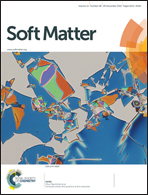Equilibrium cluster fluids: pair interactions via inverse design†
Abstract
Inverse methods of statistical mechanics are becoming productive tools in the design of materials with specific microstructures or properties. While initial studies have focused on solid-state design targets (e.g., assembly of colloidal superlattices), one can alternatively design fluid states with desired morphologies. This work addresses the latter and demonstrates how a simple iterative Boltzmann inversion strategy can be used to determine the isotropic pair potential that reproduces the radial distribution function of a fluid of amorphous clusters with prescribed size. The inverse designed pair potential of this “ideal” cluster fluid, with its broad attractive well and narrow repulsive barrier at larger separations, is qualitatively different from the so-called SALR form most commonly associated with equilibrium cluster formation in colloids, which features short-range attractive (SA) and long-range repulsive (LR) contributions. These differences reflect alternative mechanisms for promoting cluster formation with an isotropic pair potential, and they in turn produce structured fluids with qualitatively different static and dynamic properties. Specifically, equilibrium simulations show that the amorphous clusters resulting from the inverse designed potentials display more uniformity in size and shape, and they also show greater spatial and temporal resolution than those resulting from SALR interactions.


 Please wait while we load your content...
Please wait while we load your content...